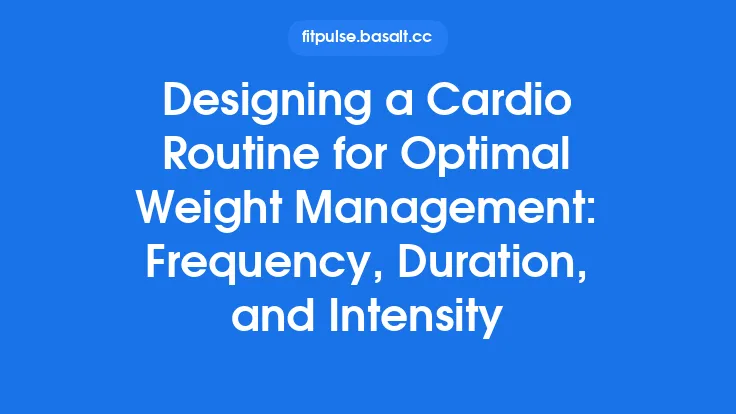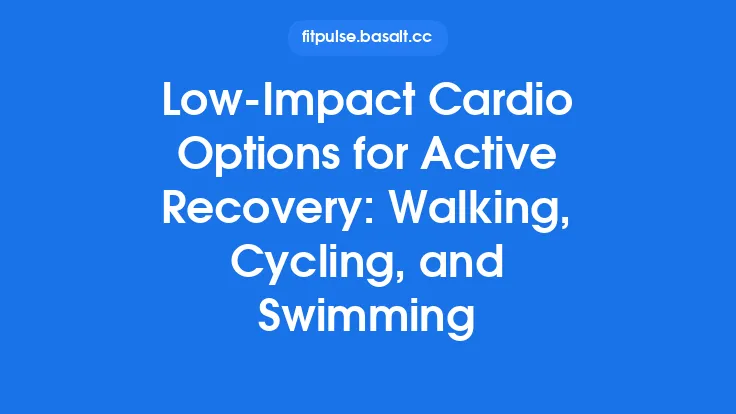Balancing cardio and recovery is the linchpin of any sustainable weight‑management plan. While the calories you burn during a run, bike ride, or rowing session are often the headline numbers people track, the hidden work that happens after the workout—repair, adaptation, and hormonal reset—determines whether those calories translate into lasting fat loss or a frustrating plateau. Below is a comprehensive guide that walks you through the science, the practicalities, and the strategic planning needed to pair cardio with optimal recovery for effective weight management.
Understanding the Energy Equation in Weight Management
Weight change is fundamentally an energy balance equation: energy intake vs. energy expenditure. Cardio contributes to the “expenditure” side, but the total picture includes:
| Component | What It Is | Typical Contribution |
|---|---|---|
| Resting Metabolic Rate (RMR) | Calories burned at complete rest (breathing, circulation, cellular processes) | ~60‑75 % of total daily energy expenditure (TDEE) |
| Thermic Effect of Food (TEF) | Energy used to digest, absorb, and store nutrients | ~10 % of TDEE |
| Non‑Exercise Activity Thermogenesis (NEAT) | Everyday movements (fidgeting, walking, chores) | Highly variable, can be 5‑30 % of TDEE |
| Exercise‑Induced Energy Expenditure (EIEE) | Calories burned during structured cardio sessions | 5‑15 % of TDEE, depending on volume and intensity |
When cardio is over‑prescribed without adequate recovery, the body may compensate by reducing RMR (a phenomenon known as metabolic adaptation) and by increasing NEAT in a way that blunts the net calorie deficit. Understanding that cardio is only one piece of the energy puzzle underscores why recovery is essential: it preserves RMR, maintains NEAT, and prevents the body from entering a “conservation mode.”
Why Recovery Is Not Optional
Recovery is the period during which the body processes the stress imposed by cardio, repairs micro‑damage, and restores homeostasis. Skipping or minimizing recovery can lead to:
- Hormonal Imbalance – Elevated cortisol and reduced testosterone can promote fat storage, especially around the abdomen.
- Mitochondrial Fatigue – Repeated high‑intensity bouts without replenishment diminish the capacity of mitochondria to oxidize fat efficiently.
- Neuromuscular Diminishment – Central nervous system (CNS) fatigue reduces coordination and the ability to sustain proper form, increasing injury risk.
- Reduced RMR – Chronic overtraining can lower resting metabolic rate, eroding the calorie deficit you worked to create.
In short, recovery protects the very mechanisms that make cardio an effective tool for weight loss.
Types of Cardio and Their Recovery Demands
Not all cardio sessions tax the body equally. Recognizing the recovery profile of each modality helps you schedule workouts intelligently.
| Cardio Modality | Primary Energy System | Typical Recovery Time* |
|---|---|---|
| Low‑Intensity Steady State (LISS) – brisk walking, easy cycling | Aerobic (fat oxidation) | 24 h (mostly muscular, minimal CNS load) |
| Moderate‑Intensity Continuous Training (MICT) – steady jog, moderate rowing | Aerobic (glycogen + fat) | 24‑48 h (muscle glycogen depletion) |
| High‑Intensity Interval Training (HIIT) – sprint intervals, Tabata | Anaerobic (phosphocreatine, glycolytic) + aerobic | 48‑72 h (CNS and hormonal recovery) |
| Tempo/Threshold Work – sustained effort just below lactate threshold | Aerobic with high lactate clearance demand | 36‑48 h (muscular and metabolic) |
| Cross‑Training (e.g., swimming, elliptical) – varied muscle recruitment | Mixed | Depends on intensity; generally 24‑48 h |
\*Recovery time is a guideline; individual variability (fitness level, age, sleep, nutrition) will shift these windows.
Periodizing Cardio for Sustainable Fat Loss
Periodization—systematically varying training variables over time—prevents the body from adapting to a single stimulus and reduces overtraining risk. A typical macrocycle for weight management might span 12‑16 weeks and be broken down as follows:
| Phase | Duration | Focus | Cardio Structure | Recovery Emphasis |
|---|---|---|---|---|
| Foundation | 3‑4 weeks | Build aerobic base, improve mitochondrial density | 3‑4 LISS sessions (45‑60 min) + 1 light strength day | Emphasize sleep hygiene, hydration, active recovery (light walking) |
| Build | 4‑6 weeks | Increase intensity, introduce metabolic stress | 2 MICT (30‑45 min) + 1 HIIT (15‑20 min) + 1 LISS | Incorporate post‑HIIT protein‑carb recovery snack, foam rolling, contrast showers |
| Peak | 2‑3 weeks | Maximize calorie burn while preserving lean mass | 2 HIIT + 1 tempo run + 1 LISS | Deload week after peak: reduce volume by 40‑50 % and focus on restorative modalities (massage, yoga) |
| Transition | 1‑2 weeks | Allow full systemic reset | Minimal cardio (1‑2 easy sessions) | Prioritize sleep, balanced macro intake, mental relaxation |
By cycling through these phases, you keep the metabolic rate elevated, avoid chronic cortisol elevation, and give the body regular windows to fully recover.
Monitoring Fatigue and Adjusting Load
Objective data can guide when to push and when to pull back. Two practical tools are:
- Heart‑Rate Variability (HRV) – A higher HRV generally indicates a well‑recovered autonomic nervous system. A drop of >10 % from baseline over 2‑3 days suggests the need for a lighter session or an extra rest day.
- Rate of Perceived Exertion (RPE) & Session RPE (sRPE) – After each cardio workout, rate the difficulty on a 0‑10 scale. An upward trend in RPE for the same workload signals accumulating fatigue.
If either metric flags excessive strain, adjust the upcoming week by:
- Reducing intensity (e.g., swapping a HIIT day for a moderate‑intensity session)
- Shortening duration by 20‑30 %
- Adding an active‑recovery day (light swim, easy bike)
Practical Recovery Strategies Between Sessions
Recovery is a multi‑dimensional process. Below are evidence‑based tactics you can implement daily:
| Strategy | How It Works | Implementation Tips |
|---|---|---|
| Post‑Exercise Nutrition | Replenishes glycogen, supplies amino acids for repair, blunts cortisol spikes | Within 30 min: 1:3–1:4 carbohydrate‑to‑protein ratio (e.g., banana + whey shake) |
| Hydration & Electrolytes | Restores plasma volume, supports mitochondrial function | Aim for 500 ml water + 300‑500 mg sodium post‑session; adjust for sweat rate |
| Compression Garments | Improves venous return, reduces muscle oscillation | Wear calf or full‑leg compression for 1‑2 h after intense cardio |
| Cold‑Water Immersion (CWI) | Attenuates inflammation, accelerates clearance of metabolic by‑products | 10‑15 min at 10‑12 °C; limit to 2‑3 sessions per week to avoid blunting adaptations |
| Active Recovery | Low‑intensity movement promotes blood flow without adding stress | 10‑20 min of easy cycling or walking the day after a HIIT session |
| Foam Rolling / Myofascial Release | Reduces muscle stiffness, improves range of motion | 5‑10 min per major muscle group, focusing on calves, hamstrings, quadriceps |
| Sleep Hygiene | Critical for hormonal regulation and glycogen restoration | 7‑9 h of uninterrupted sleep; maintain consistent bedtime, limit blue‑light exposure 1 h before bed |
These strategies can be mixed and matched based on personal preference, schedule, and the intensity of the cardio performed.
Integrating Strength Training to Support Cardio Goals
While the article’s focus is cardio, incorporating resistance work is a proven method to protect lean mass during a calorie deficit, which in turn sustains a higher resting metabolic rate. A balanced weekly plan might look like:
- 2–3 strength sessions (full‑body or split) on non‑cardio days or after low‑intensity cardio.
- Emphasize compound lifts (squat, deadlift, press) to recruit large muscle groups.
- Keep the volume moderate (3‑4 sets of 8‑12 reps) to avoid excessive CNS fatigue that could interfere with cardio recovery.
The synergy between cardio and strength training creates a “metabolic double‑dip”: cardio burns calories during the session, while strength training elevates post‑exercise oxygen consumption (EPOC) and preserves muscle tissue.
Common Pitfalls and How to Avoid Them
| Pitfall | Why It Undermines Weight Management | Fix |
|---|---|---|
| “All‑or‑Nothing” Cardio Days | Excessive volume spikes cortisol, depletes glycogen, prolongs recovery | Split long sessions into two shorter ones or incorporate interval formats |
| Neglecting Recovery Nutrition | Incomplete glycogen refill leads to reduced performance and lower RMR | Plan post‑cardio meals/snacks in advance; keep portable options handy |
| Ignoring Early Signs of Overtraining | Chronic fatigue reduces daily NEAT and can cause hormonal drift | Use HRV or simple morning mood/energy questionnaires to catch trends early |
| Repeating the Same Intensity Weekly | The body adapts, causing a plateau in calorie burn | Rotate intensity (LISS, MICT, HIIT) across weeks as part of periodization |
| Over‑Reliance on Passive Rest | Complete inactivity can lead to stiffness and slower metabolic turnover | Add active recovery or low‑intensity movement on rest days |
Putting It All Together: A Sample Weekly Blueprint
Below is a concrete example that blends cardio, recovery, and strength work while respecting the principles discussed. Adjust the times and intensities to match your fitness level.
| Day | Session | Duration / Intensity | Recovery Focus |
|---|---|---|---|
| Mon | LISS (brisk walk or easy bike) | 45 min @ 55‑65 % HRmax | Post‑walk protein shake, 10 min foam roll |
| Tue | Strength (full‑body) | 4 exercises × 3 sets × 10 reps | Hydration, 15 min light stretching |
| Wed | HIIT (sprint intervals) | 10 × 30 s sprint / 90 s jog | CWI 10 min, HRV check next morning |
| Thu | Active Recovery (light swim) | 30 min easy pace | Focus on breathing, gentle mobility work |
| Fri | MICT (steady run) | 35 min @ 70‑75 % HRmax | Post‑run carb‑protein snack, compression socks |
| Sat | Strength (upper‑body focus) | 4 exercises × 3 sets × 12 reps | Adequate protein intake, 20 min yoga for mobility |
| Sun | Rest or optional easy walk | ≤30 min very low intensity | Prioritize sleep, balanced meals, mental relaxation |
Key takeaways from the schedule:
- Varied intensity prevents adaptation and keeps metabolic rate elevated.
- Recovery modalities are paired directly after the most demanding sessions (HIIT, MICT).
- Strength days are placed on days with lower cardio stress to protect CNS capacity.
- Active recovery is used strategically to promote blood flow without adding metabolic load.
Final Thoughts
Effective weight management through cardio is not a marathon of endless high‑intensity sessions; it’s a carefully choreographed dance between stimulus and recovery. By:
- Recognizing cardio’s role within the broader energy‑balance equation,
- Respecting the distinct recovery demands of each cardio modality,
- Applying periodization to cycle intensity and volume,
- Monitoring objective fatigue markers, and
- Implementing evidence‑based recovery tactics,
you create an environment where the body can continuously burn fat, preserve lean tissue, and maintain a healthy resting metabolic rate. The result is not just short‑term weight loss, but a sustainable, long‑lasting shift in body composition that feels both achievable and enjoyable.





